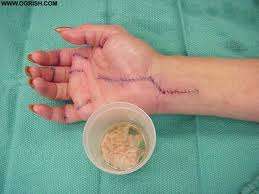Carpal Tunnel

What is carpal tunnel syndrome?
Carpal tunnel syndrome is compression or pressure on the median nerve at the wrist level. Alignment at the wrist creates a tunnel through which the median nerve and nine tendons course. The median nerve supplies sensation to the thumb, index, long finger, and half of the ring finger, thus patients’ complaints are altered sensation in these digits. You can test yourself for carpal tunnel syndrome by simply maximally bending the wrist down and waiting one minute. If you have increased symptoms of abnormal feeling in these digits, then you may well have carpal tunnel syndrome.
What causes carpal tunnel syndrome?
There can be many causes of carpal tunnel syndrome. Jobs that require excessive bending of the wrist tend to increase the pressure around the median nerve in the wrist. Similarly, sleeping with your wrist in an acutely bent position will increase pressure on the median nerve and cause carpal tunnel syndrome. Diabetes, alcoholism, hypothyroidism, and obesity are also all factors towards developing carpal tunnel syndrome.
What is the best treatment for carpal tunnel syndrome?
Carpal tunnel syndrome can vary from just a small amount of pressure to extreme pressure, and in the late stages of carpal tunnel syndrome, surgery may be necessary to release a short ligament at the wrist level. Earlier on the best treatment will involve using a splint which keeps your wrist completely flat and is worn at night. This will decrease the excessive pressure that can develop at night when the wrist naturally goes into a bent position. Make sure that the splint you wear at night keeps your wrist completely flat.
What about laser carpal tunnel surgery?
There have been no published reports to suggest that laser can improve or cure carpal tunnel syndrome.
What about endoscopic carpal tunnel surgery?
The “classic” surgery for carpal tunnel syndrome involves an open technique where a small incision is made over the region of the ligament which compresses the median nerve. This ligament is released to decompress the median nerve. With the introduction of endoscopic surgery in other locations in the body, some hand surgeons are using a similar technique at the wrist. Usually two small incisions would be substituted for one larger incision at the wrist level. The incidence of nerve injury is slightly higher with the endoscopic surgery, but the return to work time may be slightly earlier. Because of the slight increased risk to the median and ulnar nerves associated with endoscopic carpal tunnel surgery, the majority of surgeons prefer an open technique. It is recommended that you discuss in detail these two types of surgery with the particular surgeon you have chosen to do your surgery.
I know several people who have had carpal tunnel surgery and it has not improved their symptoms. Why would this be?
The likely answer is that these people have other things going on rather than just carpal tunnel syndrome. remember that carpal tunnel syndrome will only produce altered sensation in the thumb, index, long, and half of the ring finger. Any other symptoms that you have of pain or numbness in the upper extremity is not due to carpal tunnel syndrome and should be evaluated for other levels of nerve compression or muscle and tendon problems.
I know one person who following their carpal tunnel surgery had worse pain with a burning sensation at the incision and numbness and pain in the ring and long fingers. What should they do?
This may relate to a small nerve injury of the median nerve. If is does not resolve over a few months, then they should seek a surgical consultation as this is not the “normal” course following carpal tunnel surgery.







